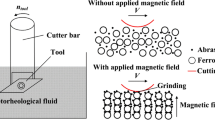Abstract
Spiral polishing mechanism refers to the technology of applying a high-speed turning screw rod in the process of workpiece surface polishing. For the purpose of increasing the machining effect, a powerful ring magnet was installed around the workpiece. In this study, the new self-developed magneto-elastic abrasive would be used to polish the inner wall of the bore, the so-called workpiece surface, under the attraction of the surrounding magnet and the drive of the turning rod. The new magneto-elastic abrasive not only eased the polishing force by its flexibility but also avoided deep scratches on the workpiece surface. The control of machining parameters on surface roughness and material removal were discussed to look for the best combination of the parameters; at the same time, the effects of each parameter on the workpiece surface topography after the polishing were also examined. The results of the experiment indicated that magnetic flux density and magneto-elastic abrasive concentration affected the surface roughness the most. In addition, the newly developed magneto-elastic abrasive significantly improved the polishing effect of the workpiece surface, at the rate of 94 %.
Similar content being viewed by others
References
Liao HT, Shie JR, Yang YK (2008) Applications of Taguchi and design of experiments methods in optimization of chemical mechanical polishing process parameters. Int J Adv Manuf Technol 38:674–682
Tian YB, Zhong ZW, Lai ST, Ang YJ (2013) Development of fixed abrasive chemical mechanical polishing process for glass disk substrates. Int J Adv Manuf Technol 68:993–1000
Mali HS, Manna A (2012) Simulation of surface generated during abrasive flow finishing of Al/SiCp-MMC using neural networks. Int J Adv Manuf Technol 61:1263–1268
Kenda J, Duhovnik J, Tavcar J, Kopac J (2014) Abrasive flow machining applied to plastic gear matrix polishing. Int J Adv Manuf Technol 71:141–151
Walia RS, Shan HS, Kumar P (2006) Abrasive flow machining with additional centrifugal force applied to the media. Mach Sci Technol 10:341–354
Sankar MR, Mondal S, Ramkumar J, Jain VK (2008) Experimental investigations and modeling of drill bit-guided abrasive flow finishing (DBG-AFF) process. Int J Adv Manuf Technol 42:678–688
Sankar MR, Jain VK, Ramkumar J (2010) Rotational abrasive flow finishing (R-AFF) process and its effects on finished surface topography. Int J Mach Tools Manuf 50:637–650
Sankar MR, Jain VK, Ramkumar J (2009) Experimental investigations into rotating workpiece abrasive flow finishing. Wear 267:43–51
Walia RS, Shan HS, Kumar P (2009) Enhancing AFM process productivity through improved fixturing. Int J Adv Manuf Technol 44:700–709
Kar KK, Ravikumar NL, Tailon PB, Ramkumar J, Sathiyamoorthy D (2009) Performance evaluation and rheological characterization of newly developed butyl rubber based media for abrasive flow machining process. J Mater Process Technol 209:2212–2221
Jha S, Jain VK (2004) Design and development of the magnetorheological abrasive flow finishing (MRAFF) process. Int J Mach Tools Manuf 44:1019–1029
Singh S, Shan HS (2002) Development of magneto abrasive flow machining process. Int J Mach Tools Manuf 42:953–959
Wani AM, Yadava V, Khatri A (2007) Simulation for the prediction of surface roughness in magnetic abrasive flow finishing (MAFF). J Mater Process Technol 190:282–290
Jain VK (2009) Magnetic field assisted abrasive based micro-/nano-finishing. J Mater Process Technol 209:6022–6038
Das M, Jain VK, Ghoshdastidar PS (2012) Nanofinishing of flat workpieces using rotational–magnetorheological abrasive flow finishing (R-MRAFF) process. Int J Adv Manuf Technol 62:405–420
Yang B, Tzeng H, Huang F, Lin Y, Chow H (2007) Finishing effects of spiral polishing method on micro lapping surface. Int J Mach Tools Manuf 47:920–926
Chen WC, Wu KL, Yan BH, Tsao MC (2013) A study on the magneto-assisted spiral polishing on the inner wall of the bore with magnetic hot melt adhesive particles (MHMA particles). Int J Adv Manuf Technol 69:1791–1801
Author information
Authors and Affiliations
Corresponding author
Additional information
This paper has not been published elsewhere, nor has it been submitted for publication elsewhere.
Rights and permissions
About this article
Cite this article
Chen, WC., Wu, KL. & Yan, BH. A study on the application of newly developed magneto-elastic abrasive to improving the surface roughness of the bore. Int J Adv Manuf Technol 73, 1557–1566 (2014). https://doi.org/10.1007/s00170-014-5942-0
Received:
Accepted:
Published:
Issue Date:
DOI: https://doi.org/10.1007/s00170-014-5942-0



